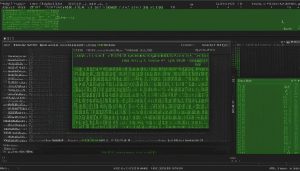Welcome to an exciting journey into the world of Linux Lite! In this article, I will introduce you to the fundamentals of Linux Lite and highlight its features, installation process, and requirements. Whether you’re a beginner or someone curious about this user-friendly operating system, you’ve come to the right place.
Linux Lite is a lightweight and beginner-friendly version of the Linux operating system. It offers a simple and easy-to-use interface, making it ideal for those who are new to Linux. Based on the popular Ubuntu distribution, Linux Lite provides all the essential features and tools needed to start your Linux journey.
Key Takeaways:
- Linux Lite is a beginner-friendly version of Linux.
- It is based on the Ubuntu distribution.
- Linux Lite offers a user-friendly interface and essential features.
- The installation process is straightforward.
- Minimum system requirements should be considered before installation.
The History and Evolution of Linux
Linux, as we know it today, has a rich history and a fascinating evolution. It all started in 1991 when Linus Torvalds developed the Linux kernel, inspired by the Unix operating system. Since then, Linux has grown into a powerful and versatile operating system that has revolutionized the world of computing.
One of the remarkable aspects of Linux is the vast number of distributions available. These distributions are different variations of the Linux operating system, each tailored to meet specific needs and preferences. Some of the most popular distributions include Debian, Fedora, and Ubuntu, which serve different purposes and cater to various user communities.
Linux has become synonymous with open-source software and collaboration. Its development is driven by a global community of developers and enthusiasts who contribute their expertise and knowledge to improve the system continuously. This collaborative effort has played a significant role in shaping Linux into the robust and reliable operating system it is today.
The Evolution of Linux Versions
Linux has undergone several major releases over the years, each introducing new features and improvements. Let’s take a look at some of the notable versions of Linux and their contributions to the evolution of the operating system:
| Linux Version | Release Year | Key Features |
|---|---|---|
| Linux 0.01 | 1991 | The initial release of Linux by Linus Torvalds |
| Linux 1.0 | 1994 | Introduction of the first stable version of Linux |
| Linux 2.4 | 2001 | Significant improvements in performance and stability |
| Linux 3.0 | 2011 | Introduction of the “big version number change” |
| Linux 4.0 | 2015 | Simplified numbering scheme, improved hardware support |
| Linux 5.0 | 2019 | Enhancements for emerging technologies like AI and IoT |
The continuous development and innovation within the Linux community have propelled the operating system to new heights. Linux has become the foundation for numerous technological advancements, powering everything from smartphones and computers to servers and supercomputers. Its robustness, security, and flexibility make it an ideal choice for individuals and organizations worldwide.
Linux continues to evolve at a rapid pace, with new versions and distributions being released regularly. As technology advances and new challenges arise, Linux remains at the forefront, driving innovation and pushing the boundaries of what is possible.
What Can Linux Lite Be Used For?
Linux Lite is a versatile operating system that can be used for a wide range of purposes. Whether you need it for desktop applications or server environments, Linux Lite provides the tools and features to meet your needs. Here are some of the key uses of Linux Lite:
Linux Lite Applications
Linux Lite comes pre-installed with a variety of applications for everyday use. You’ll find web browsers, office productivity tools, multimedia players, and more. These applications are carefully selected to provide a comprehensive set of tools for your daily tasks. And if you need additional software, you can easily install it from the Linux Lite software repository, which offers a vast collection of applications for various purposes.
Linux Lite Server
Linux Lite is also an excellent choice for server applications. Its stability and security make it suitable for hosting websites, setting up home servers, or running enterprise-level applications. Linux Lite is compatible with a wide range of server software, providing the necessary performance and support for your server needs. Whether you’re a beginner or an experienced system administrator, Linux Lite offers the flexibility and reliability you require.
Linux Lite Desktop
Linux Lite is designed to provide a user-friendly desktop environment. Its intuitive interface allows beginners to easily navigate and perform tasks without any hassle. The desktop can be customized to suit your preferences, whether you prefer a clean and minimalistic look or a more personalized setup. With Linux Lite, you have the freedom to make your desktop environment truly yours.
With its versatility and user-friendly interface, Linux Lite is a powerful operating system that can be used for various purposes. Whether you need it for everyday applications, server environments, or desktop customization, Linux Lite has you covered. Its extensive features and wide range of compatibility make it an excellent choice for beginners and experienced Linux users alike.
Key Features of Linux Lite
Linux Lite offers a range of features that make it an attractive choice for beginners. Its lightweight and user-friendly desktop environment provides a seamless experience for users. With its intuitive interface, users can easily navigate and perform tasks without any technical expertise. The Linux Lite desktop environment is designed to be simple and efficient, allowing users to focus on their work without distractions.
One of the standout features of Linux Lite is its high level of customization. Users can personalize their desktop according to their preferences, changing wallpapers, themes, and icons to create a unique look and feel. This flexibility allows users to make Linux Lite truly their own. Additionally, Linux Lite offers extensive hardware compatibility, ensuring that it runs smoothly on a wide range of devices, including older or less powerful hardware. This makes it an ideal choice for users looking to revive their old machines or make the most out of their existing hardware.
Another important aspect of Linux Lite is its software repository. With thousands of applications available, users have access to a vast selection of software to meet their needs. The Linux Lite software repository provides a convenient way to discover and install new applications, whether it’s productivity tools, multimedia players, or development software. This extensive software library ensures that users have all the necessary tools at their disposal to maximize their Linux Lite experience.
Table: Linux Lite Key Features
| Feature | Description |
|---|---|
| Lightweight Desktop Environment | A user-friendly interface that is easy to navigate and perform tasks. |
| Customization | Opportunity to personalize the desktop with various themes, wallpapers, and icons. |
| Hardware Compatibility | Ability to run on older or less powerful hardware. |
| Software Repository | A vast collection of applications for various needs and preferences. |
Is Linux Lite an Open Source Operating System?
Yes, Linux Lite is an open-source operating system. Being open source means that the source code of Linux Lite is freely available and can be viewed, modified, and distributed by anyone. This allows developers and users to contribute to the improvement of the operating system and customize it according to their needs. Linux Lite is based on Ubuntu, which is also an open-source operating system. Both Linux Lite and Ubuntu are licensed under the GNU General Public License (GPL), which ensures that the software remains free and open to the public. The open-source nature of Linux Lite promotes collaboration, innovation, and transparency.
Open-source software has several advantages over proprietary software. It allows for greater flexibility and customization, as users have access to the source code and can modify it to suit their specific requirements. It also promotes community-driven development, as developers from around the world can contribute their expertise to enhance the software. Additionally, open-source software often benefits from frequent updates and improvements, as a large community of developers works to identify and fix bugs and add new features.
The open-source nature of Linux Lite also ensures its compatibility with a wide range of hardware. Since the source code is freely available, developers can optimize it to work efficiently on different systems and architectures. This makes Linux Lite a versatile and reliable operating system that can be installed on various devices, from low-end machines to high-performance servers.
Benefits of Linux Lite being open source:
- Flexibility and customization
- Community-driven development
- Frequent updates and improvements
- Compatibility with a wide range of hardware
Overall, the open-source nature of Linux Lite makes it a powerful and accessible operating system for users of all levels of technical expertise. Whether you are a beginner or an experienced user, Linux Lite offers the freedom, security, and versatility that comes with open-source software.
| Benefit | Description |
|---|---|
| Flexibility and customization | Users have the freedom to customize Linux Lite according to their specific needs and preferences by modifying its source code. |
| Community-driven development | The open-source nature of Linux Lite encourages collaboration and enables developers from around the world to contribute to its improvement. |
| Frequent updates and improvements | As an open-source operating system, Linux Lite benefits from a large community of developers who work together to identify and fix bugs, as well as add new features and enhancements. |
| Compatibility with a wide range of hardware | The open-source nature of Linux Lite allows developers to optimize the operating system for different hardware configurations, making it compatible with a variety of devices and architectures. |
By harnessing the power of open-source development, Linux Lite continues to evolve and provide users with a reliable and customizable operating system that empowers them to take full control of their computing experience.
Conclusion
In summary, Linux Lite is the perfect Linux distribution for beginners. With its user-friendly interface, extensive software selection, and customizable options, it offers a smooth transition into the world of Linux. Based on Ubuntu, Linux Lite provides compatibility and support, ensuring a seamless experience for users.
Whether you’re using Linux Lite for desktop purposes or server applications, it has all the essential features and tools you need. The lightweight nature of Linux Lite makes it suitable for older or less powerful hardware, allowing you to make the most of your resources without compromising performance.
Linux Lite is not only user-friendly but also an open-source operating system. This means that its source code is freely available, promoting collaboration and transparency. As a result, Linux Lite benefits from ongoing development and customization from the community, ensuring continuous improvement.
In conclusion, Linux Lite is a reliable and versatile choice for beginners looking to explore the benefits of a lightweight and user-friendly Linux distribution. Whether you’re a desktop user or need a server solution, Linux Lite has you covered with its impressive features and extensive compatibility.
FAQ
What is Linux Lite?
Linux Lite is a user-friendly version of the Linux operating system that is specifically designed for beginners. It offers a simple and easy-to-use interface, making it an ideal choice for those who are new to Linux.
Is Linux Lite free to download and use?
Yes, Linux Lite is free to download and use. It is an open-source operating system, which means that the source code is freely available and can be viewed, modified, and distributed by anyone.
What are the system requirements for Linux Lite?
The minimum system requirements for Linux Lite are a 1.5 GHz processor, 1 GB of RAM, and 10 GB of free disk space. However, it is recommended to have a 2 GHz dual-core processor, 4 GB of RAM, and 25 GB of free disk space for optimal performance.
Can Linux Lite run on older or less powerful hardware?
Yes, Linux Lite is known for its strong hardware compatibility. It can run on older or less powerful hardware without any issues, allowing users to breathe new life into their old machines.
How do I install Linux Lite?
Installing Linux Lite is a straightforward process. You can download the ISO file from the official website, create a bootable USB or DVD, and follow the on-screen instructions to install it on your computer.
What software comes pre-installed with Linux Lite?
Linux Lite comes with a wide range of pre-installed software, including web browsers, office productivity tools, multimedia players, and more. This allows users to start using their Linux Lite system right away.
Can I customize the desktop environment in Linux Lite?
Yes, Linux Lite provides a high level of customization. You can personalize your desktop environment, change themes, customize the panel, and add or remove shortcuts to make it your own.
Can I install additional software on Linux Lite?
Yes, Linux Lite has an extensive software repository with thousands of applications that can be easily installed and managed. You can use the built-in software manager to browse and install the software you need.
Is Linux Lite suitable for server applications?
Yes, Linux Lite is suitable for server applications. It offers stability, security, and compatibility with a range of server software, making it a popular choice for hosting websites, setting up home servers, or running enterprise-level applications.
Can I contribute to the development of Linux Lite?
Yes, Linux Lite is an open-source operating system, which means that you can contribute to its development. You can view, modify, and distribute the source code, and collaborate with other developers and users to improve the operating system.
Hi, I’m Mark, the author of Clever IT Solutions: Mastering Technology for Success. I am passionate about empowering individuals to navigate the ever-changing world of information technology. With years of experience in the industry, I have honed my skills and knowledge to share with you. At Clever IT Solutions, we are dedicated to teaching you how to tackle any IT challenge, helping you stay ahead in today’s digital world. From troubleshooting common issues to mastering complex technologies, I am here to guide you every step of the way. Join me on this journey as we unlock the secrets to IT success.


